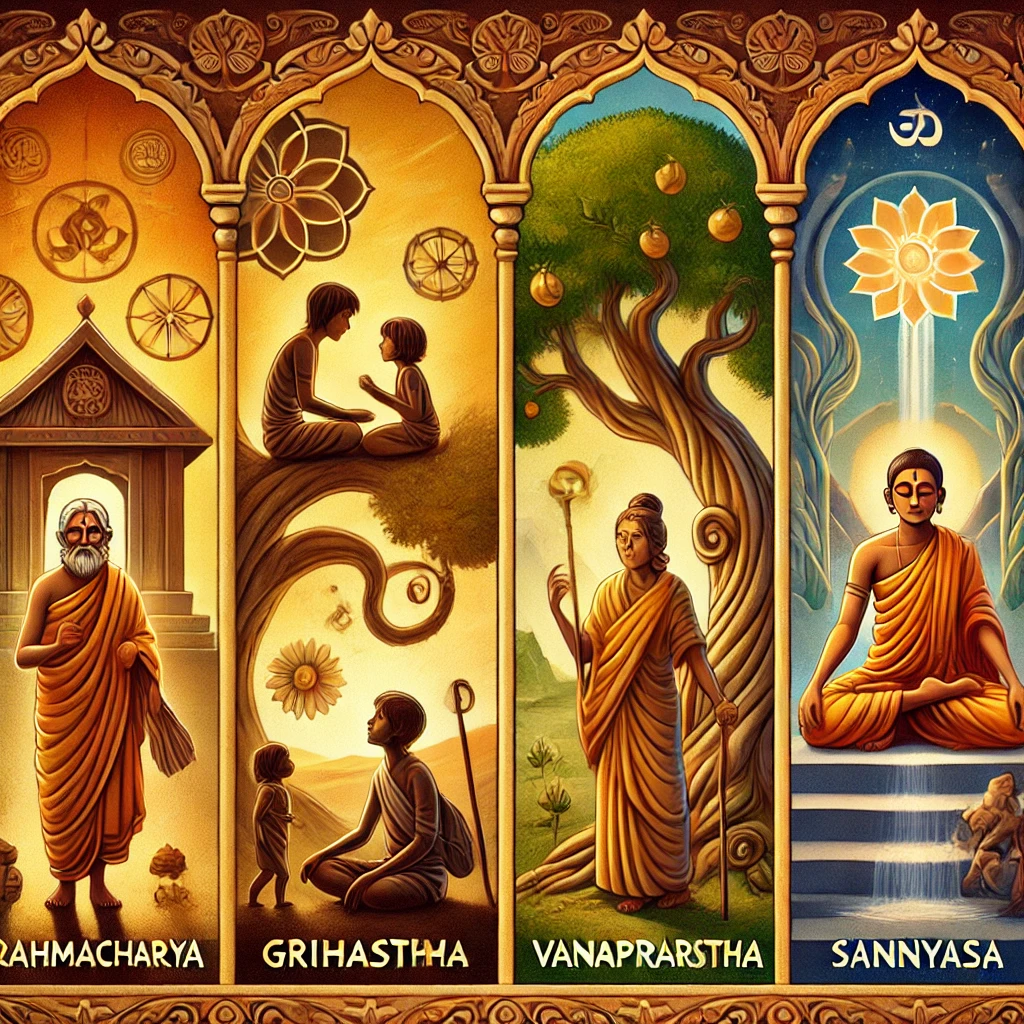
🧭 What is the Ashrama System?
In Hinduism, life is seen not just as a biological journey, but as a sacred path of personal evolution, divided into four meaningful stages. This journey—known as the Ashrama System—guides individuals through a balanced blend of responsibility, growth, detachment, and spiritual liberation.
These stages are:
- Brahmacharya (Student)
- Grihastha (Householder)
- Vanaprastha (Retiree/Hermit)
- Sannyasa (Renunciate)
Each ashrama outlines a unique purpose, set of duties, and spiritual focus, creating a framework for living a life in harmony with dharma (righteous living) and moksha (liberation).
🔍 Why It Matters
The Ashrama system helps answer key life questions:
- When should I focus on learning?
- When should I dedicate myself to family?
- When is it time to reflect and let go?
- How do I achieve spiritual freedom?
Whether you’re seeking personal growth, spiritual insight, or simply a structured approach to life, this ancient guide still holds powerful relevance today.
📘 The Four Ashramas: Explained
1. 🧑🎓 Brahmacharya – The Student Life (Ages 0–25)
Key Themes: Learning, Self-Discipline, Character Building
This is the foundational stage—where an individual focuses on:
- Acquiring knowledge (Vedas, sciences, arts)
- Practicing self-control and celibacy
- Developing ethics and inner discipline
- Honoring teachers (Gurus) and family values
“Brahmacharya is not just about celibacy—it’s about sharpening the mind and character for future responsibilities.”
Modern Parallel: Students cultivating skills, ethical values, and mental focus.
2. 🏡 Grihastha – The Householder Life (Ages 25–50)
Key Themes: Marriage, Family, Career, Social Contribution
This is the busiest and most outwardly engaged stage. Responsibilities include:
- Marriage and raising children
- Earning wealth ethically (artha)
- Contributing to society and practicing hospitality
- Upholding dharma through daily rituals and social duties
Modern Parallel: Balancing work, parenting, community involvement, and personal values.
3. 🌿 Vanaprastha – The Retired Life (Ages 50–75)
Key Themes: Detachment, Mentorship, Spiritual Transition
In this stage, individuals begin to:
- Gradually withdraw from worldly responsibilities
- Transfer household duties to the next generation
- Engage in reflection, scriptural study, and meditation
- Mentor youth and share life’s wisdom
Modern Parallel: Volunteering, spiritual retreats, giving back to the community.
4. 🧘♂️ Sannyasa – The Renounced Life (Age 75+)
Key Themes: Liberation, Renunciation, Spiritual Mastery
This final stage is marked by:
- Full detachment from material and emotional bonds
- Pursuit of moksha (liberation from rebirth)
- Living as a monk, teacher, or ascetic
- Inspiring others through spiritual practice
Modern Parallel: Embracing minimalism, simplicity, and inner peace—whether in a monastery or your own home.
📊 Summary Table: Ashrama System at a Glance
| Stage | Age Range | Core Focus | Primary Duties |
|---|---|---|---|
| Brahmacharya | 0–25 | Knowledge, Discipline | Study, celibacy, spiritual grounding |
| Grihastha | 25–50 | Family, Contribution | Marriage, career, parenting, community service |
| Vanaprastha | 50–75 | Reflection, Detachment | Mentorship, scriptural study, spiritual focus |
| Sannyasa | 75+ | Renunciation, Liberation | Simplicity, meditation, detachment, teaching |
🧘♀️ The Spiritual Goals of Each Stage
Each Ashrama corresponds to a larger Hindu goal of life (Purusharthas):
- Dharma (righteousness) → all stages
- Artha (wealth) → Grihastha
- Kama (desire) → Grihastha
- Moksha (liberation) → Vanaprastha and Sannyasa
Together, they weave a life of balance, duty, joy, and liberation.
🌐 Relevance in the Modern World
Remixing the Ashramas Today
Even in today’s fast-paced society, the Ashrama system offers timeless wisdom:
| Traditional Stage | Modern Application |
|---|---|
| Brahmacharya | Lifelong learning, mindfulness, student ethics |
| Grihastha | Work-life balance, ethical living, raising mindful kids |
| Vanaprastha | Retirement, volunteering, spiritual study |
| Sannyasa | Minimalism, inner peace, conscious living |
The goal isn’t to follow the stages rigidly, but to integrate their essence into everyday life.
🧭 Final Thoughts: Why the Ashrama System Still Matters
The Ashrama system provides more than a religious script—it’s a lifelong guide to living with intention, balance, and harmony.
Whether you’re 18 or 80, reflecting on the Ashramas can offer:
- 🧠 Perspective on life’s seasons
- 🧘♂️ Grounding in spiritual values
- ❤️ Purpose in your day-to-day journey
Embrace the wisdom of the Ashramas—and let your life become a journey of growth, service, reflection, and liberation.
